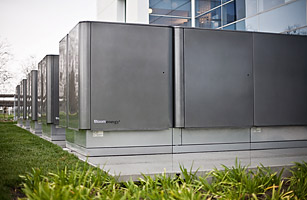
Sometimes high tech can start out low tech. Fuel cells are an old and basic technology; they generate electricity within a cell through the reaction of a fuel and an oxidant. Essentially they're a kind of chemical battery, and your average high school chemistry class can make one. Unlike batteries, however, they can't store electricity; you need an outside fuel source that has to be replenished over time. But their simplicity has also made them useful for certain purposes; NASA has long used hydrogen fuel cells to power its spacecraft.
Inventors have tried to use hydrogen fuel cells as a cleaner way to create electricity commercially. Honda and other car companies have made hydrogen fuel cell-powered cars, for example, but they've always been limited by the cost. That's beginning to change, however, thanks to a California startup called Bloom Energy. The company exploded onto the public scene earlier this year with the release of its Bloom Box, a system that uses fuel cell technology to provide off-the-grid power. The Bloom Boxes — about half the size of a shipping container — use solid oxide fuel cells, which generate electricity by oxidizing natural gas. The technology has existed for awhile, but Bloom figured out how to carry out the reaction at a relatively low temperature, making the Bloom Boxes safe to use in corporate offices — which is exactly where they're being put to work now, by companies like Google and eBay that can use the lower carbon power as an off-the-grid back up to conventional grid electricity and as a way to reduce their own carbon footprint.